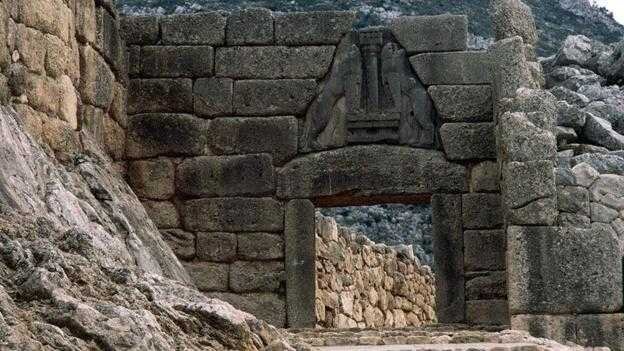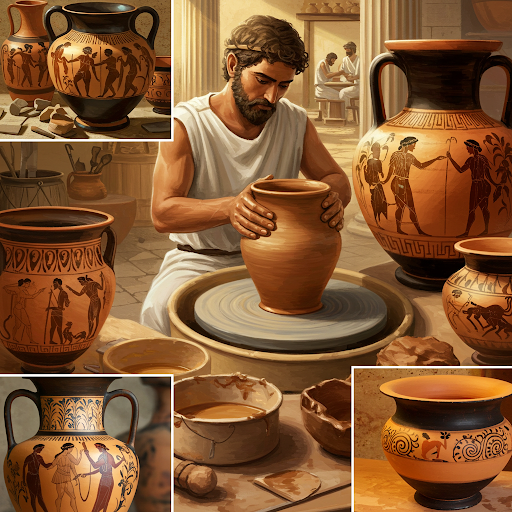We think of the Greeks as the orderly people who gave us drama, democracy and philosophy. But the fearsome creatures in Hellenic art reveal a dark side, writes Alastair Sooke.
By Alastair Sooke
What do you think about when you hear the words ‘ancient Greece’? The conventional view is that the ancient Greeks provided the bedrock for Western civilisation. After all, they invented democracy, philosophy and drama. But it would be a mistake to imagine them as exclusively rational. Their society was shaped by strange and primal forces as much as the guiding light of reason. And nowhere is this more visible than in their art.
One of the most intriguing aspects of ancient Greek art is its glut of fantastical creatures. When we consider Greek art, we tend to envisage marble statues of Olympian gods – but gorgons, griffins, centaurs and sphinxes are actually just as common. What was the significance of all these ferocious supernatural beasts? Fantastical animals were already part of the repertoire of Aegean craftsmen in prehistory, a millennium before the high point of the classical age in Athens in the Fifth Century BC. For instance, they star in the art of both the Minoan and Mycenaean civilisations of the Bronze Age.
The famous ‘Throne Room’ in the Minoan palace at Knossos on Crete was decorated with frescoes of elegant griffins – hybrid creatures with the bodies of lions and the heads of birds of prey. They flanked the chamber’s so-called throne, as though conferring supernatural power upon whoever sat there.
Lions or griffins? The stone beasts that flank the entrance to citadel of Mycenae have lost their heads – so we cannot be sure (De Agostini/Getty Images)
At the site of Mycenae on mainland Greece, the splendid ‘Lion Gate’, a monumental limestone relief featuring two leonine creatures on either side of a central column, dominates one entrance to the citadel. Because these beasts are headless (the lost heads, which would have faced outwards, were once attached using dowel pins), there is a theory that they weren’t lions at all, but griffins – perhaps in honour of the griffins that had appeared in earlier Minoan art.
Dark days?
Traditionally, historians term the chaotic period that followed the catastrophic breakdown of the Mycenaean palace centres as the ‘Dark Ages’. Yet a significant find from a cemetery near the modern town of Lefkandi on the large Greek island of Euboea suggests greater sophistication during these murky centuries than was previously thought.
It is a ceramic figurine dating from the 10th Century BC that depicts a sweet-looking monster: half-man, half-horse. He is probably a centaur (an unruly creature from the fringes of civilisation), offering a surprisingly early example of a sculptor portraying a character from Greek mythology. Five hundred years later, centaurs would play a prominent role among the extravagant public sculptures adorning the Parthenon in Athens.
Yet according to Peter Stewart, director of the Classical Art Research Centre at the University of Oxford, the exploding popularity of “mixed creatures” such as centaurs really occurred around the Seventh Century BC. “This is sometimes called the ‘orientalising period’,” he says, “and we start to find a profusion of fantastic creatures on Greek pottery, metalwork, and other media influenced by the art of the Near East and Egypt.”
The Metopes of the Parthenon – a frieze that adorned the building’s outer wall – depicts battle between Centaurs and men (Peter Horree / Alamy)
In this period, ancient Greek society was still under the influence of foreign cultures. For Greek merchants, it was a time of prosperity, as they traded right across the Mediterranean. To give thanks for their good fortune, these enterprising seafarers often dedicated bronze cauldrons to their gods in religious sanctuaries. Decorating the rims of these magnificent objects were monstrous heads influenced by the art of far-flung peoples.
“Perhaps this imagery had connotations of exotic and prestigious imports,” explains Stewart, “but it probably also echoed the characters of Greek mythology and religious belief.” A popular choice for decorating cauldrons was the savage, sharp-beaked griffin, which reappeared in Greek art with ferocious flair – and an oriental flavour – having disappeared from view for centuries.
Human turn
Fantastical creatures in ancient Greek art now had their utmost ferocity and bristling, bare-fanged power. But a century or two later, artists would present monsters in a radically different fashion. “In the Greek world,” explains Joan Mertens, curator of Greek and Roman art at the Metropolitan Museum, “many creatures that start off ferocious and ugly evolve into beautiful figures or animals. Perhaps the most dramatic example is the gorgon Medusa who in early Greek art is all fangs and wrinkles and by the mid-Fifth Century is a beautiful woman.”
The frieze of Medusa at the Temple of Apollo at Didyma has a recognisably human face (Interfoto/Alamy)
As ancient Greece shifted into the classical era, says Stewart, “The most noticeable trend is that the monsters become more realistic. As artists become more interested in realistic bodies, and more able to represent them, it perhaps becomes a challenge to show fantastic creatures in a plausible way.”
We find a good example of this in the satyrs – mischievous, often sexually aroused and inebriated human figures with pointy ears and horses’ tails – that appear on so many painted pots in ancient Greece. “On Athenian painted pots of the late Sixth and Fifth Centuries BC,” says Stewart, “satyrs are often shown as wild, chaotic creatures beyond the civilised world of the city. But at least as often they perform human roles, introducing an element of anarchy into otherwise very urbane activities like symposia (drinking parties). Occasionally they actually behave like refined Athenian citizens. These are very ironic images, no doubt intended to provoke thought or amusement, but they do exhibit a lot of sympathy for the satyrs.”
This last thought is instructive when it comes to considering the meaning of monsters in ancient Greece. It is tempting to understand them in opposition to concepts of Greekness: scary, ‘other’ beings that needed to be shoved beyond the perimeters of civilisation. But perhaps the attitude of the ancient Greeks towards monsters was more nuanced.
As Stewart puts it: “I don’t think that Greeks really expected to meet a centaur or sphinx, or even a satyr, out in the countryside, and maybe they were always regarded as the stuff of legend. But a recurring trait of Greek art is that monstrous creatures seem to be held up as a foil to the Greeks’ concept of civilisation – a sort of distorting mirror in which the Greeks could look at themselves. The Greeks seem to have found these monstrous or semi-human creatures useful to explore and express their world-view, their ideas about humanity and civilisation, the mortal and divine. Fantastical beings were part of the furniture of the Greek mind.”
Alastair Sooke is art critic of The Daily Telegraph.












